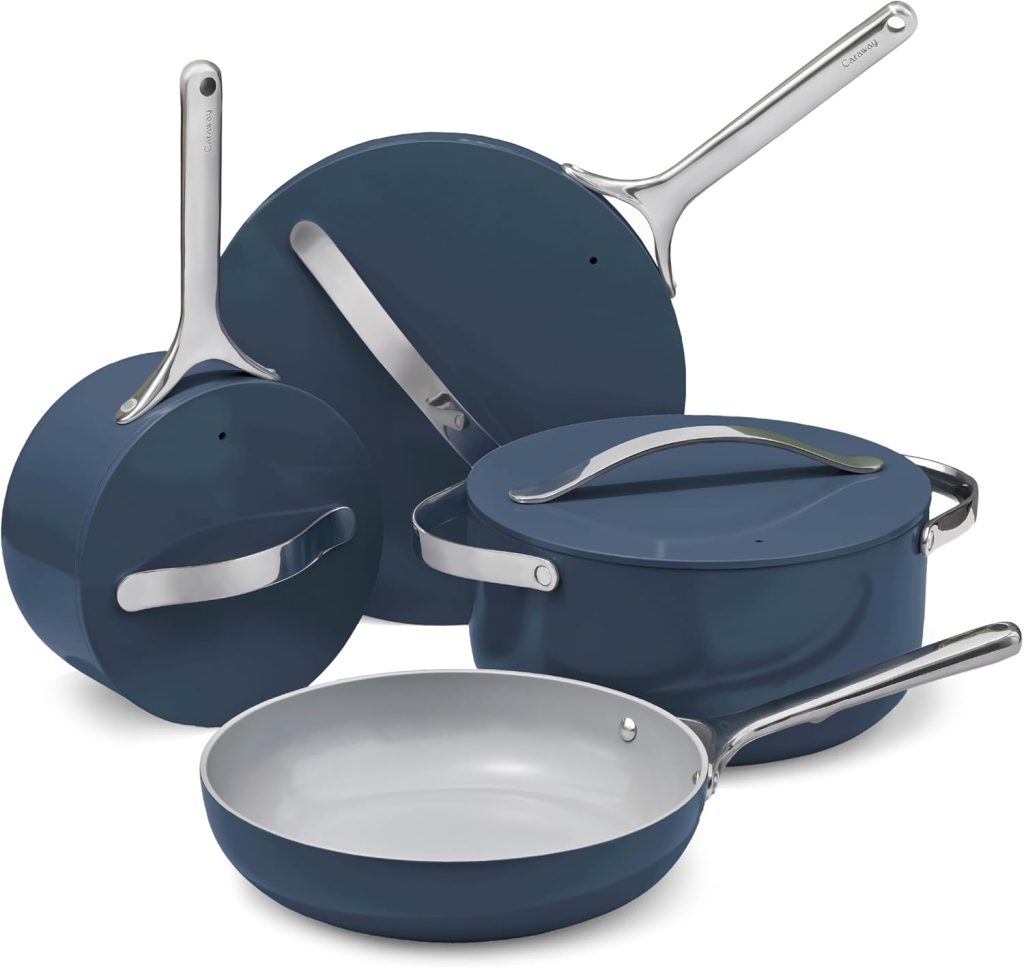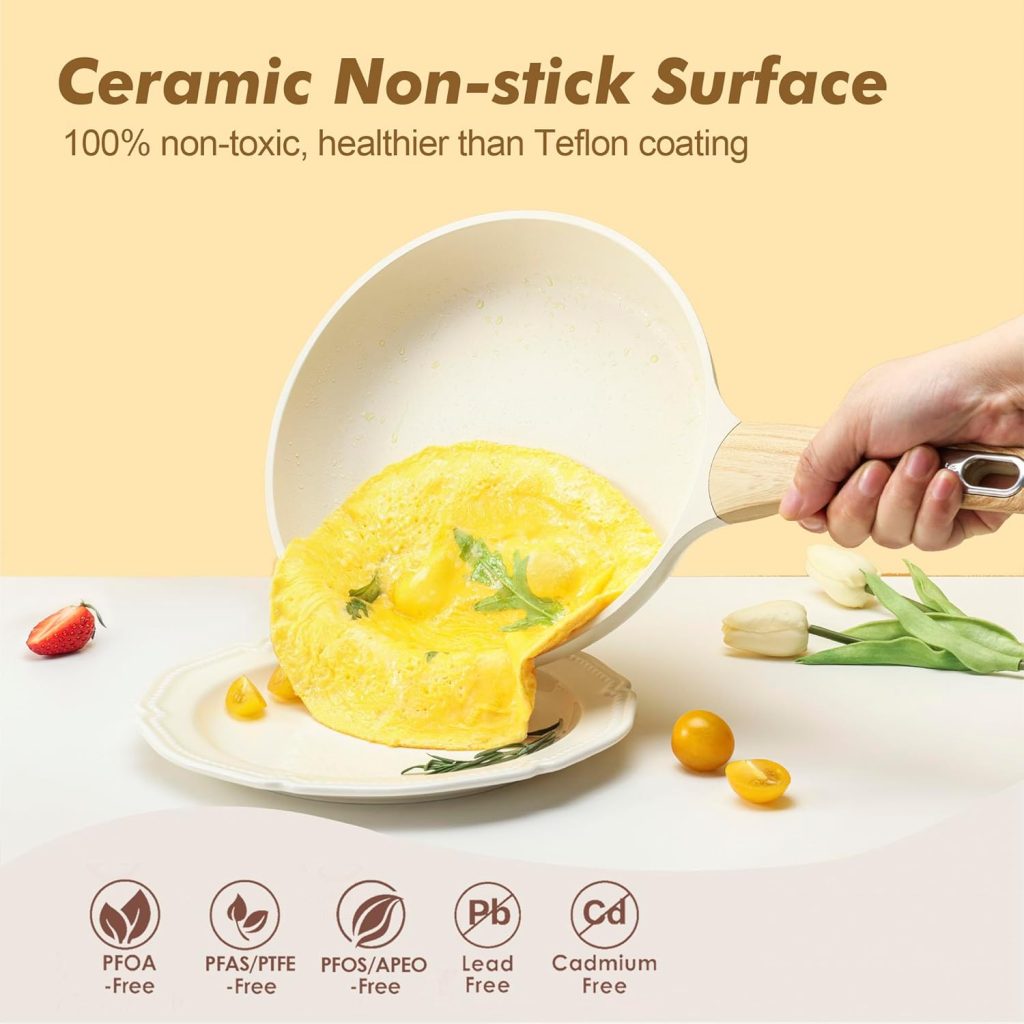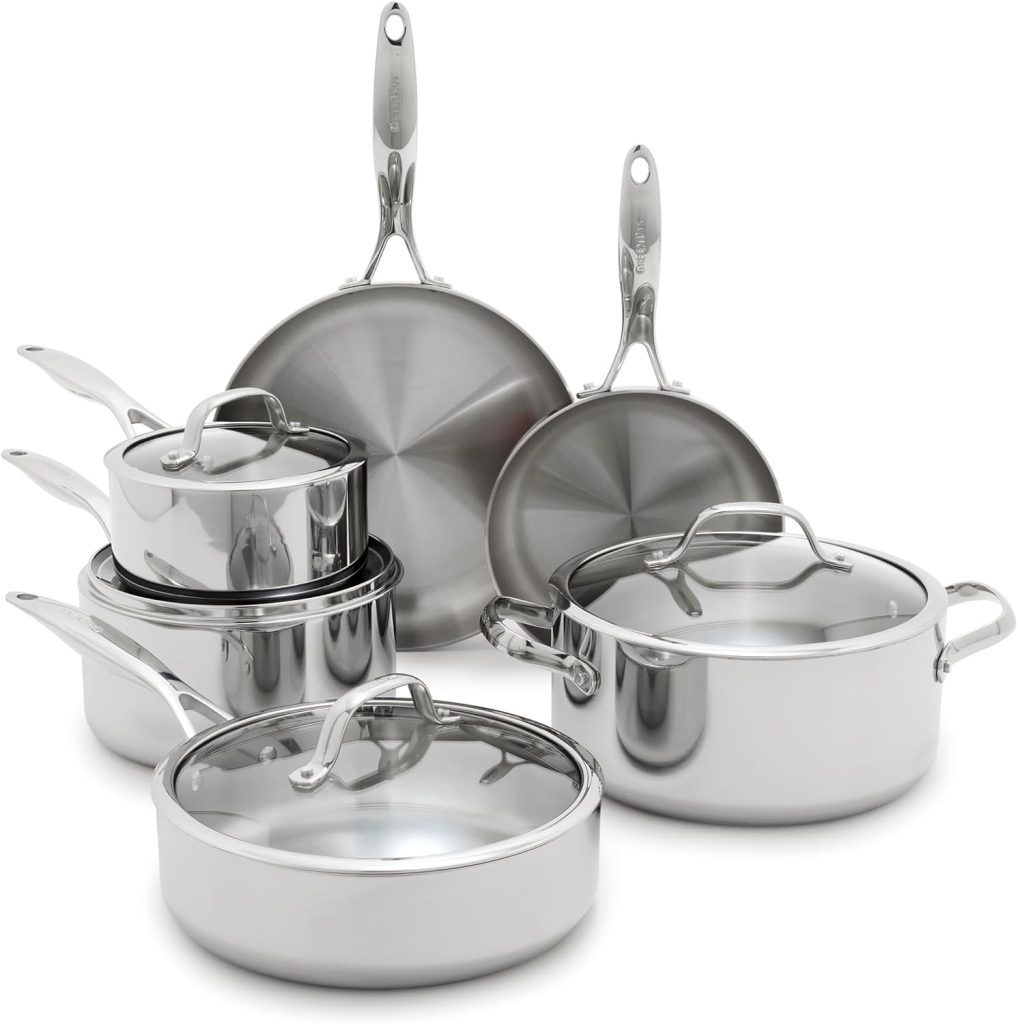You’re browsing the cookware aisle, drawn to those beautifully colored ceramic pans promising a healthier cooking experience.
The packaging screams “non-toxic” and “eco-friendly,” but a nagging question lingers in your mind: Is ceramic cookware safe for my family?
With growing concerns about chemicals leaching into food and conflicting information online, choosing the right cookware feels overwhelming.
The truth is, ceramic cookware safety depends on several critical factors: the manufacturing quality, coating composition, and how you use these pans daily.
While many modern ceramic options offer genuine non-toxic benefits, not all ceramic cookware is created equal, and understanding the difference could protect your health for years to come.
What Is Ceramic Cookware?
The term “ceramic cookware” actually encompasses two distinct categories, and understanding this difference is crucial for evaluating safety.
Many consumers assume all ceramic pans are made entirely from natural materials, but the reality is more complex.
Pure Ceramic vs Ceramic-Coated Cookware
Pure ceramic cookware is manufactured entirely from inorganic clay materials that are kiln-fired at extremely high temperatures, creating a naturally non-stick, glass-like surface.
Brands like Xtrema specialize in this 100% ceramic construction. In contrast, ceramic-coated cookware features a metal base—typically aluminum or steel—covered with a thin ceramic non-stick layer.
This coating gives the appearance and some benefits of ceramic while maintaining the lightweight properties of metal.
Common Base Materials (Aluminum or Steel Core with Ceramic Coating)
Most ceramic cookware sold today uses an aluminum or stainless steel core beneath the ceramic coating.
Aluminum provides excellent heat conductivity and keeps pans lightweight, while steel offers greater durability and compatibility with induction cooktops.
The ceramic layer is applied through a sol-gel process, creating that signature smooth, non-stick finish consumers love.
How the Non-Stick Ceramic Surface Is Created (Silica-Based Sol-Gel Process)
The ceramic coating itself is created through a sophisticated sol-gel technique using silica (silicon dioxide) as the primary component.
Manufacturers mix silica with water and other compounds to form a gel, which is then applied to the metal base and cured at high temperatures.
This process transforms the gel into a hard, glass-like ceramic surface that’s naturally slippery without requiring synthetic polymers like PTFE.
Why Ceramic Cookware Is Marketed as “Non-Toxic”
The rise of non-toxic ceramic cookware stems from growing consumer awareness about potentially harmful chemicals in traditional non-stick coatings.
Ceramic brands have capitalized on health concerns by positioning their products as the safer alternative.
PTFE- and PFOA-Free Labeling (vs Traditional Teflon)
The primary selling point for ceramic cookware is its absence of polytetrafluoroethylene (PTFE), commonly known as Teflon, and perfluorooctanoic acid (PFOA), a chemical formerly used in PTFE production.
When traditional non-stick pans are overheated beyond 500°F, they can release toxic fumes.
Ceramic coatings avoid this risk entirely because they contain no PFAS-free cookware compounds—the family of “forever chemicals” linked to various health concerns.
BPA- and Lead-Free Claims in Newer Brands
Modern ceramic cookware manufacturers also emphasize that their products are free from bisphenol A (BPA), a plasticizer, and lead, a heavy metal.
While BPA isn’t typically used in cookware manufacturing, the claim resonates with health-conscious consumers familiar with BPA concerns in plastic containers.
Lead-free certification has become particularly important after testing revealed some older ceramic products contained dangerous lead levels.
Popular Eco-Brands Promoting “Green” Ceramic Coatings
Companies like GreenLife, GreenPan, and Caraway have built entire brand identities around eco-friendly ceramic non-stick pans safety.

These brands emphasize sustainable manufacturing processes, recycled materials, and transparent ingredient lists.
Their marketing appeals to environmentally conscious consumers seeking healthier cooking options without sacrificing the convenience of non-stick surfaces.
However, it’s essential to look beyond marketing claims and examine actual safety certifications.
Does Ceramic Cookware Contain Lead or Cadmium?

This question addresses one of the most serious concerns about ceramic cookware safety.
The answer isn’t straightforward and depends heavily on the product’s origin and manufacturing standards.
Vintage or Imported Ceramic Coatings May Contain Lead/Cadmium Pigments
Older ceramic cookware and some imported products, particularly decorative ceramic dishes not intended for cooking, have tested positive for lead and cadmium.
These heavy metals were historically used as pigments to create vibrant colors in ceramic glazes.
When these surfaces contact acidic foods or become scratched, lead can leach into meals at dangerous levels.
This is especially concerning with vintage pieces or inexpensive imports from countries with less stringent regulations.
Modern Brands Are Regulated Under FDA + California Prop 65 Limits
Reputable manufacturers of lead-free ceramic cookware now comply with strict U.S. Food and Drug Administration standards and California Proposition 65 requirements, which set maximum allowable limits for lead and cadmium in food-contact surfaces.
These regulations have dramatically improved ceramic cookware safety in recent years.
Major brands selling in the U.S. market must demonstrate compliance or face legal consequences and recalls.
How to Verify “Lead-Free” Certification from Credible Manufacturers
Look for explicit “lead-free” and “cadmium-free” statements on product packaging or manufacturer websites.
Reputable brands like GreenPan, Caraway, and Xtrema provide detailed safety information and third-party testing documentation.
If testing your cookware for lead concerns you, independent testing services and home test kits are available, though professional laboratory analysis provides the most accurate results.
Pure Ceramic vs Ceramic-Coated Cookware
Understanding the distinction between these two types is essential for making informed safety decisions about your cookware investment.
Pure Ceramic = Made Entirely from Clay, Fired at High Temperatures
Pure ceramic cookware, exemplified by brands like Xtrema, consists entirely of inorganic clay materials fired at temperatures exceeding 2000°F.
This process creates an extremely stable, non-reactive cooking surface that won’t degrade over time.
Are ceramic pans safe for health when made this way?
Pure ceramic represents the safest option because there’s no coating to wear off or a metal core to potentially leach through damaged surfaces.
Ceramic-Coated = Metal Base with a Silica or Titanium Ceramic Topcoat
Ceramic-coated cookware vs pure ceramic presents important trade-offs.
Coated versions use a thin ceramic layer (typically 50-100 microns thick) applied to aluminum or steel.
Some manufacturers enhance this coating with titanium dioxide for added durability.
While these pans are generally safe when new and properly maintained, the coating can wear down with use, exposing the metal underneath.
Safety Comparison — Coating Wear, Potential Leaching, and Durability
The safety of ceramic-coated pans depends largely on coating integrity.
An intact ceramic surface prevents any interaction between food and the metal base.
However, once scratched or degraded, the protective barrier is compromised.
Pure ceramic eliminates this concern but comes with its own challenges: greater weight, higher cost, and increased fragility.
When comparing whether enamel cookware is safe to cook with versus ceramic options, both offer non-reactive surfaces when undamaged.
Performance Trade-Offs (Weight, Heat Retention, Fragility)
Pure ceramic cookware is significantly heavier and more brittle than ceramic-coated alternatives, making it prone to chipping or cracking if dropped.
However, it excels at even heat distribution and retention.
Ceramic-coated pans are lighter and more convenient for daily use, but typically lose their non-stick properties within 1-3 years of regular use, requiring replacement sooner than pure ceramic or other cookware types.
Is Ceramic Cookware Safe for Everyday Cooking?
The safety of ceramic cookware for daily use depends on several controllable factors related to how you purchase, use, and maintain these products.
When Ceramic Is Safest — Intact Coating, Medium Heat, Non-Abrasive Use
Ceramic cookware performs best and safest when used with medium or low heat settings.
Unlike stainless steel or cast iron, ceramic coatings aren’t designed for high-heat searing.
Keeping temperatures below 500°F preserves coating integrity and prevents any potential degradation.
Using wooden, silicone, or nylon utensils rather than metal spatulas prevents scratching the delicate surface.
How Scratched or Degraded Coatings Increase Leaching Risk
Once the ceramic coating becomes scratched, worn, or visibly degraded, the safety equation changes.
Damaged coatings may expose the aluminum or steel base underneath, and if those metals aren’t of food-grade quality, they could potentially leach into acidic foods.
Additionally, microscopic particles from deteriorating coatings might end up in food, though research on the health effects of ingesting ceramic coating particles remains limited.
Proper Care Practices to Maintain Coating Integrity
To maximize ceramic cookware safety and longevity, always hand-wash pans with soft sponges rather than abrasive scrubbers, even if labeled dishwasher-safe.
Avoid thermal shock by letting pans cool before washing. Store pans with protective padding between them to prevent scratching.
Never use cooking sprays, which create sticky residue that degrades non-stick performance.
Following these practices can extend coating life from months to years.
Common Concerns with Ceramic Cookware
Despite marketing promises, ceramic cookware comes with legitimate drawbacks that consumers should understand before purchasing.
Coating Wear and Loss of Non-Stick Function Over Time
The most common complaint about ceramic cookware is that the non-stick surface degrades relatively quickly.
Many users report that, within 6-18 months of regular use, food begins to stick despite proper care.
This happens because the ceramic coating gradually wears away due to repeated heating and cooling and contact with utensils.
While traditional Teflon cookware maintains its non-stick performance for years, ceramic coatings degrade much faster.
This durability difference often leads consumers to wonder if non-stick cookware is really safe for cooking in the long term.
Possible Nanoparticle Release from Low-Quality Coatings
Some researchers have raised concerns about nanoparticle release from ceramic coatings, particularly lower-quality products.
During manufacturing, some ceramic coatings incorporate nanoparticles of titanium dioxide or other materials to enhance properties.
When these coatings degrade, microscopic particles could potentially transfer to food.
However, comprehensive long-term studies on health effects remain limited, and reputable manufacturers use more stable formulations.
Misleading “100% Ceramic” Marketing (Many Are Coated Metal)
Marketing language often misleads consumers into believing they’re purchasing pure ceramic when they’re actually getting ceramic-coated metal cookware.
Phrases like “ceramic non-stick” or “ceramic-inspired” typically indicate a coating rather than solid ceramic construction.
This distinction matters significantly for safety, durability, and performance expectations.
Greenwashing in the Eco-Cookware Market
The explosion of “green” and “eco-friendly” ceramic cookware has attracted some brands more interested in capitalizing on health trends than delivering genuinely safer products.
Some companies make vague non-toxic claims without providing specific certification or testing documentation.
Others emphasize minor environmental features while ignoring more significant safety concerns.
Critical evaluation of specific safety credentials matters more than general eco-marketing language.
How to Identify Safe Ceramic Cookware
Navigating the ceramic cookware market requires knowing which specific features and certifications indicate genuinely safer products.
Look for Certified “Lead-Free,” “PFAS-Free,” and “Prop 65 Compliant” Cookware
The safest ceramic cookware brands clearly state their products are certified lead-free, cadmium-free, and PFAS-free.
California Proposition 65 compliance is particularly meaningful because California maintains some of the strictest chemical exposure standards in the United States.
Products bearing this certification have been tested to ensure they don’t contain chemicals known to cause cancer or reproductive harm at dangerous levels.
Prefer Transparent Brands (GreenPan, Caraway, Xtrema, Our Place)
How to identify non-toxic ceramic cookware starts with choosing manufacturers that provide detailed information about their materials, manufacturing processes, and safety testing.
Brands like GreenPan openly discuss their Thermolon coating composition, Caraway provides extensive safety documentation, Xtrema emphasizes its pure ceramic construction, and Our Place offers transparency about their coating technology.
This openness suggests companies are confident in their product safety.
Check Labeling, Product Pages, and Testing Documentation
Don’t rely solely on front-of-package marketing.
Review detailed product descriptions, specification sheets, and safety documentation on manufacturer websites.
Look for mentions of third-party testing by recognized laboratories.
Some brands provide batch testing results or certificates of analysis upon request. If safety information isn’t readily available, that’s a red flag.
Avoid Cheap Imports Without Safety Claims
Budget-priced ceramic cookware from unknown manufacturers, particularly imports without clear country-of-origin labeling or safety certifications, presents the highest risk.
These products may use inferior materials, lack quality control, or contain heavy metals in glazes.
While price doesn’t always correlate with safety, extremely cheap ceramic cookware should raise concerns, especially when specific safety claims are absent.
Testing and Certification Standards
Understanding the regulatory framework helps consumers interpret safety claims and certifications on ceramic cookware products.
FDA Limits for Lead and Cadmium in Food-Contact Surfaces
The U.S. Food and Drug Administration establishes maximum allowable levels for lead and cadmium that can leach from food-contact surfaces, including cookware.
For ceramic articles, the FDA specifies that lead release cannot exceed 3.0 micrograms per milliliter and cadmium cannot exceed 0.5 micrograms per milliliter when tested using acidic food simulants.
Does ceramic cookware contain lead legally? Not above these thresholds, though some products have violated these limits.
California Proposition 65 and European LFGB Standards
California Proposition 65 requires warnings for products containing chemicals that cause cancer or reproductive harm above certain thresholds, creating strong incentives for manufacturers to reformulate products.
European LFGB (Lebensmittel- und Futtermittelgesetzbuch) standards are even more stringent, particularly regarding heavy metals and chemical migration.
Products meeting both U.S. and European standards offer the highest confidence in safety.
What Third-Party Testing Labs (Like SGS) Verify
Independent testing laboratories such as SGS, Intertek, and TÜV conduct comprehensive safety evaluations that go beyond basic regulatory compliance.
These labs test for heavy metal content, chemical migration under various conditions, coating durability, and material composition.
Third-party certification provides independent verification of manufacturer claims and catches quality control issues.
What “Food-Safe” Really Means Under These Regulations
“Food-safe” certification means the product has been tested and meets specific standards for substances that could migrate from the cookware into food.
This includes limits on heavy metals, restricted chemicals, and harmful compounds.
However, food-safe doesn’t necessarily mean optimal or non-toxic; it simply means the product meets minimum legal requirements.
The most cautious consumers should look for products that exceed basic food-safe standards.
Safer Alternatives to Ceramic-Coated Cookware
For those seeking maximum safety or wanting to compare options, several alternatives to ceramic-coated cookware deserve consideration.
100% Ceramic Cookware (Xtrema)
Pure ceramic cookware like Xtrema represents the gold standard for chemical-free cooking.
Made entirely from inorganic materials with no metal core or synthetic coatings, these products eliminate concerns about coating degradation or metal leaching.
They’re oven-safe to extremely high temperatures, non-reactive with any food type, and last for decades with proper care.
The drawbacks are significant weight, brittleness, and higher cost.
Stainless Steel and Cast Iron (No Coatings)
When comparing ceramic vs stainless steel cookware, stainless steel offers unparalleled durability and safety for non-reactive cooking, though it requires more fat for non-stick performance and has a steeper learning curve.

Cast iron provides excellent heat retention and natural non-stick properties when properly seasoned, though it requires more maintenance.
Carbon steel vs ceramic cookware comparison shows carbon steel as lighter than cast iron with similar benefits.
Glass or Enamel-Coated Cast Iron (Lead-Free Brands)
Glass cookware is completely inert and transparent, making it ideal for baking and certain stovetop applications, though it’s fragile and doesn’t work on all cooktops.
Enamel-coated cast iron from reputable brands like Le Creuset or Staub combines cast iron’s heat properties with a non-reactive, easy-to-clean surface.
When evaluating an enamel vs ceramic cookware comparison, both offer similar non-reactive benefits, though enamel typically lasts longer.
Non-Toxic Brands to Consider (Caraway, GreenPan, 360 Cookware)
For consumers committed to non-stick convenience, several brands prioritize safety while delivering performance.
Caraway uses a mineral-based ceramic coating with transparent safety documentation.

GreenPan pioneered PFAS-free ceramic coatings and maintains third-party certifications.
360 Cookware offers surgical-grade stainless steel with excellent warranties.
When exploring ceramic vs Teflon cookware brands, these represent the safer end of the non-stick spectrum.
FAQs About Ceramic Cookware Safety
Ceramic cookware is generally considered safer than traditional Teflon because it contains no PTFE or PFOA, eliminating the risk of toxic fume release when overheated.
However, ceramic coatings typically wear out faster than modern Teflon alternatives, requiring more frequent replacement.
From a pure safety standpoint, undamaged ceramic is preferable, but from a longevity perspective, newer PFOA-free Teflon formulations may actually last longer.
High-quality, undamaged ceramic cookware from reputable manufacturers doesn’t leach harmful chemicals into food when used properly.
However, cheap or damaged ceramic coatings may release particles or, if they contain heavy metals, could potentially leach lead or cadmium.
The ceramic material itself (silica-based) is chemically stable and non-reactive, but coating quality and integrity determine actual safety.
Most ceramic-coated cookware is oven-safe up to temperatures between 350°F and 500°F, depending on the handle material. Check manufacturer specifications.
However, despite many brands claiming dishwasher safety, hand-washing significantly extends coating life.
Harsh dishwasher detergents and high heat accelerate coating degradation, diminishing non-stick performance and potentially compromising safety.
Both brands represent safer options within their categories.
Xtrema’s 100% ceramic construction eliminates coating concerns, making it one of the safest choices available, though heavy and fragile.
Caraway uses a ceramic coating that’s PTFE-free, PFOA-free, and PFAS-free, with third-party testing confirmation.
Both are significantly safer than conventional non-stick cookware, though pure ceramic (Xtrema) has a slight edge in absolute safety.
Conclusion — Ceramic Cookware Is Safe When Verified and Properly Used
Modern ceramic cookware safety has improved dramatically with stricter regulations and consumer awareness.
When you choose certified lead-free, PFAS-free products from transparent manufacturers, ceramic cookware offers a genuinely safer alternative to traditional non-stick options.
The key lies in selecting quality products with documented safety testing, using them correctly with medium heat and gentle utensils, and replacing them when coatings show signs of wear.
While no cookware is perfect, verified ceramic options provide an excellent balance between convenience and health-consciousness.
For maximum safety, consider pure ceramic construction, but for most home cooks, quality ceramic-coated cookware from reputable brands offers sufficient protection when properly maintained.
Your healthiest kitchen starts with informed choices about the surfaces touching your food every day.